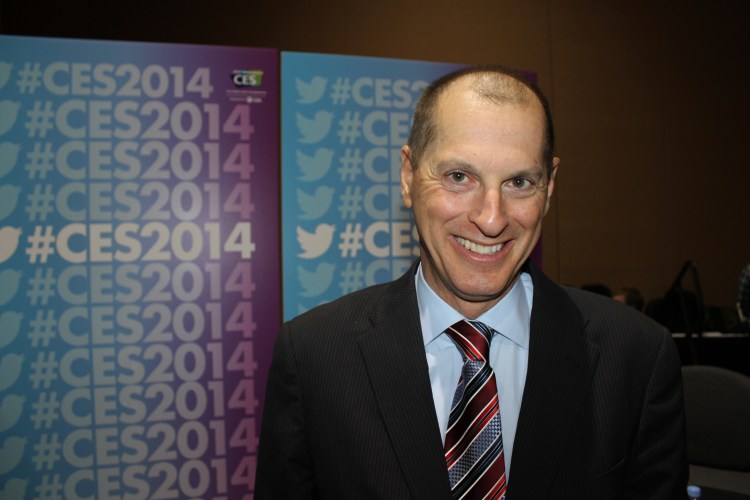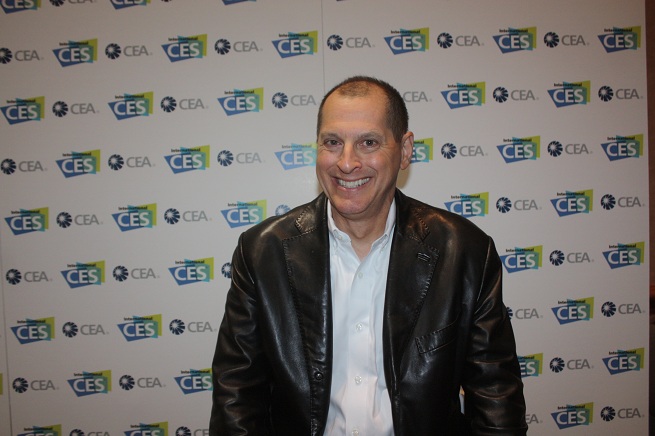VentureBeat: What are some of the top trends that are accelerating, whether it’s 3D printing or wearables or what have you?
Shapiro: The 3D printing marketplace is more than double what it was last year, both in terms of the number of companies and the size of the footprint. It’s not yet a consumer product with people rushing out to buy it. It’s very big with small businesses. We have a lot of people entering the marketplace. It’s one of these things that’s going to keep growing.
We predict the same thing with unmanned systems, what you call drones. That’s a new marketplace for us. We have a lot of new entrants, a lot of different approaches around the world. The U.S. is a little slower where this marketplace is concerned. Although yesterday the federal government announced 40 different companies using these drones. It’s a product that can do a lot of things and provide a lot of different services around the world. It’s growing quickly.
Cybersecurity is another new marketplace, as well as personal privacy (with nine exhibitors). One that’s growing very large very quickly is smart homes. Gaming is up. We have 637 exhibitors who say they have a gaming product, versus 511 last year. We had Oculus last year as part of someone else’s booth. This year they’re a huge separate exhibitor.
VentureBeat: Does anything seem to have slowed down or fizzled compared to past years?
Shapiro: Not that I’m aware of. Eureka Park is up dramatically, as I said. Smart watches are up more than 50 percent. 3D printing is up 100 percent. Our auto section has grown. Everything is bigger. The show is bigger.
VentureBeat: How are the Apple-related products?
Shapiro: I just had a meeting about planning the 2016 floor, and the thought is that we’ll expand the iLounge, the Apple-related area of the show, because Apple is introducing new products. The expectation is that with new products coming, we’ll be introducing more of that. [This year’s iLounge has shrunk from 121,000 square feet and 396 exhibitors last year to 78,000 square feet and 174 exhibitors this year, mainly because of tighter curation].
VentureBeat: What about UltraHD?
Shapiro: UltraHD isn’t a separate area of the show. It never really has been. The sales are hot on that right now. We learned yesterday that what I thought was an aggressive forecast is going to be exceeded in 2014. The TV category will be showing curved, OLED, and connected televisions. But of course 4K TV will just become TV, the same way we stopped talking about HD. Everything’s going to be UltraHD in just a few years.
VentureBeat: You guys have signaled that it’s going to be a pretty good holiday for gadgets.
Shapiro: No question about that. TVs have just gotten back on the most wanted list for gifts, speaking of. They’d been off for a few years. They’re back on because of 4K, because the prices have gotten very attractive. Smartphones and tablets and games are on there, obviously. As far as the holiday selling season, we’re seeing more consumers wanting to spend on consumer electronics than in all of our years of polling.
VentureBeat: The Internet of Things seems to be something almost every big company is talking about.
Shapiro: Technically we had an Internet of Things area at the show last time. In 2015 we don’t. But what we do have is a number so large that I didn’t believe it. 900 companies will have Internet of Things products. That seems pretty high to me. But still, this is self-identification, the companies associating themselves.
VentureBeat: Are there any interesting public policy issues that the CEA is dealing with this year? There’s no SOPA at the moment, but has anything else had you busy in Washington?
Shapiro: Where to begin? First of all, for the first time, we have all the FCC commissioners and all the FTC commissioners, including both chairmen. That’s 10 top government officials. There’s some talk that in the weeks before the show, they’re going to release this new net neutrality thing, but there’s a lot of other stuff on their plate, including spectrum options and things like that.
Congress has a lot on its plate that it needs to come back and talk about, including privacy, immigration, trade. The new trade deal in Geneva just collapsed a few hours ago, sadly. Everyone’s walking away from the information technology agreement.
VentureBeat: Why would that have been a good agreement, if you could explain it to people who aren’t familiar?
Shapiro: 10 or 20 years ago there was this thing called the Information Technology Agreement, which we pushed really hard for. It said that information technology products have no tariffs among the countries that signed the deal. That meant you could buy computers from anywhere in the world, basically — Japan, China, Korea, the U.S., Europe. Consumers got a great deal. They could buy products without any tariffs. Some countries — like Brazil, which is not a signatory — the tariffs can go up to 60 or 80 percent.
What happened was, the technology changed. A lot of things converged. Countries started putting tariffs on certain things, depending on what they wanted to do, to raise revenue or protect different industries. There have been some efforts to get together and resolve these differences. We thought we had a deal about a year ago, but then China blew it up, frankly.
President Obama, a few weeks ago, announced that he had gotten a deal with China. That was huge. What happened this week, though, looks like this deal was unacceptable to the Koreans and Taiwanese, because it excluded some products that they really cared about — monitors and things like that. We’ve been working our butts off for the past week while they’ve been meeting in Geneva to try to work it out. It’s not officially dead yet, but it may be soon.
VentureBeat: Last year we talked a lot about this boom in technology companies — all the innovation in the U.S. Do you feel that things are still strong in the U.S. and for the tech boom in general?
Shapiro: Oh, yeah. This last year, I spent less time in the office than I ever have in any year of my job. I’ve been traveling around the country and the world talking to tech councils and tech groups, going to conferences, speaking to interest groups, seeing all this stuff going on. Innovation is everywhere.
Steve Case, he had this bus that went around the country. He was giving out $100,000 investments, and there was no shortage of good ideas around the country. The U.S. is in a really good place right now. Manufacturing prices are low here. The rest of the world seems to be turning downward. Oil prices are low. The economy is strong. We’re still getting a lot of people who want to innovate here. The immigration issue is one that we want to deal with next year. Generally, though, we’re doing well. It’s a perfect storm.
VentureBeat: There’s still some tech-related societal problems — censorship, government spying, lots of hacking still going on. What are your thoughts on some of these downsides?
Shapiro: In Europe, it seems like every other day they’re doing something to hit a U.S. tech company. The strategy appears to be to put up walls around a U.S. tech sector and tax them. That’s something that’s not helping. Europe has not produced a lot of innovation and they’re frustrated about it. I was speaking about this in Geneva a few weeks ago. They really want to be something, want to do something, and unfortunately they keep choosing a path that’s very bureaucratic and not very healthy. They have some great innovation in certain areas, but the tech space in general isn’t doing well.
Spying hasn’t been helpful to U.S. companies doing business abroad. It’s been used as an excuse by the Europeans and others to try to be less available to U.S. companies. That’s an issue. We’re looking at the effect of hacking on consumers as far as credit cards. That’s where the Europeans are definitely better than us. They haven’t had the problems we’ve had, with Home Depot and Target and the like.
VentureBeat: I see CEA chief economist Shawn DuBravac has a book out about the age of data now.
Shapiro: Sean is our economist, yeah. It’s the third book from the CEA. The first two books were by me. Sean focuses on the future. It’s a great read, very interesting. He’ll be sharing the keynote space with me.
VentureBeat: What are some of your favorite thoughts about the future? Any fun things that you see technology bringing to our lives?
Shapiro: When I started out, CES was a lot about entertainment and a little bit about information and computers. Then it became about education, information, and entertainment. Now it’s fundamentally changed, as we’ve gotten into low-cost components, especially the sensors that are being put together in clever ways and solving major societal problems.
We have a special program this year focused on not only health care, but on doctors. The chief medical officer of Qualcomm is part of it, and others. We’re attracting health care professionals to see what’s going on there. At the same time, the federal government just made an announcement about reimbursing doctors getting information from an FDA-approved device. That’s a reimbursable expense, which is huge in terms of changing medical care.
Wearables are growing rapidly, and the definition of wearables is changing at this show. One company has a product, a cervical insert for women who want to know when their body is ready to conceive or not. It can do everything a Fitbit does, only more precisely. That’s really interesting.





